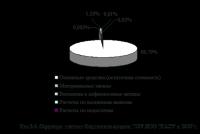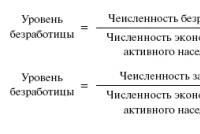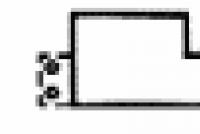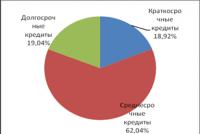Fixed asset accounting groups. Okoff is the all-Russian classifier of fixed assets. Useful life
Classification of fixed assets included in depreciation groups - a normative document in which the types of fixed assets are divided into depreciation groups (10 depreciation groups).
The classification of fixed assets included in depreciation groups is approved by the Decree of the Government of the Russian Federation of 01.01.2002 N 1.
Changes are regularly made to the document. is given at the end of this material.
Comment
For each type of fixed assets in the Classification, a code, name and note are indicated.
Within depreciation groups, fixed assets are grouped into subgroups - Machinery and equipment, Transport vehicles, Structures and transmission devices, Buildings, Dwellings, Perennial plantations, Livestock workers.
Depreciable property is pooled in the next ten depreciation groups (clause 3 of article 258 Of the Tax Code Russia):
2) For fixed assets related to 1-2 and 8-10 depreciation groups can apply amortization bonus in the amount of no more than 10% (see, clause 9 of article 258 of the Tax Code of the Russian Federation)
3) For fixed assets related to 3-7 depreciation groups a depreciation bonus of no more than 30% can be applied (see, clause 9 of article 258 of the Tax Code of the Russian Federation).
4) By fixed assets 3-7 depreciation groups can be applied (Article 286.1. Tax Code of the Russian Federation).
5) Increased depreciation rate 3 (for corporate income tax) for the leased asset does not apply to fixed assets related to 1 - 3 depreciation groups (Clause 2 of Article 259.3 of the Tax Code of the Russian Federation, see).
6) Taxpayers have the right to apply an increased depreciation factor 2 (for corporate income tax) in relation to depreciable fixed assets included in 1 - 7 depreciation groups and produced in accordance with the terms of a special investment contract (subparagraph 6 of paragraph 1 of Article 259.3 of the Tax Code of the Russian Federation).
7) In relation to buildings, structures, transmission devices 8 - 10 depreciation groups only the straight-line depreciation method can be applied (for corporate income tax). The non-linear depreciation method cannot be applied to such assets (clause 3 of article 259 of the Tax Code of the Russian Federation, see).
Depreciation groups of some property, plant and equipment
Personal Computer refers to ➤
Multifunctional devices (MFPs) refer to ➤
Office furniture refers to ➤
Cars belong to depreciation groups depending on their type. Most of passenger cars belongs to the 3rd depreciation group of fixed assets ➤
Trucks refer to depreciation groups depending on their carrying capacity and type. Most of them belong to the 3rd - 5th depreciation groups. ➤
Building belong to 4-10 depreciation groups, depending on their type ➤
Not all types of fixed asset objects can be found in Classifications... For those types of fixed assets that are not indicated in depreciation groups, the term useful use is established by the taxpayer in accordance with the technical conditions or recommendations of the manufacturers (clause 6 of article 258 of the Tax Code of Russia).
Using the Classification of Fixed Assets in Accounting
Until January 1, 2017, paragraph 2 of clause 1 of the Decree of the Government of the Russian Federation of 01.01.2002 N 1 directly indicated the possibility of using the classification in accounting:
"This Classification may be used for accounting purposes."
But, this paragraph was excluded from 01/01/2017 by Decree of the Government of the Russian Federation of 07/07/2016 N 640. Accordingly, from 01/01/2017 in accounting, when establishing the useful life, the rules established by regulatory enactments on accounting should be applied.
Many accountants, before the adoption of clear rules for determining the useful lives of fixed assets in accounting, continue to apply the Classification for accounting.
Overview of changes that have been made to the classification of fixed assets included in depreciation groups
Resolution of the Government of the Russian Federation of April 28, 2018 N 526 "On Amendments to the Classification of Fixed Assets Included in Depreciation Groups"
05/04/2018 on the official Internet portal of legal information pravo.gov.ru.
The beginning of the document: 12.05.2018
In accordance with clause 2, the document applies to legal relations that arose from January 1, 2018.
The essence of the changes:
Subsections "Structures and transmission devices" of the Classification by 3-10 depreciation groups have been significantly adjusted. Minor adjustments for subsections "Machinery and equipment" (2, 9 depreciation groups).
The changes take into account the industry-specific features of the equipment used in the oil industry, sea and river fleet, railway industry and other industries.
Decree of the Government of the Russian Federation of 07.07.2016 N 640 "On Amending the Decree of the Government of the Russian Federation of January 1, 2002 N 1"
First official publication: 12.07.2016 on the official Internet portal of legal information pravo.gov.ru.
The beginning of the document: 01.01.2017
The essence of the changes:
The new edition contains new codes of the new OKOF classifier, which is applied from 01.01.2017 -. The changes are not only technical. Many items of the Classification have been substantially updated. So, many new positions have appeared and the positions of the classifier that were used until 2017 have been removed.
The changes are large-scale and their significance is associated with fundamental differences between the old version of OKOF and its new version, which has been applied since 2017.
Historical reference
The classification of fixed assets included in depreciation groups was put into effect on January 1, 2002 by Decree of the Government of the Russian Federation of January 1, 2002 N 1 (item 3).
Until January 1, 2002, the term “rates of depreciation deductions” was used instead of the term “depreciation group”. From January 1, 1991 to January 1, 2002, the Uniform norms of depreciation deductions for the complete restoration of fixed assets of the USSR national economy were applied, approved. Decree of the USSR Council of Ministers of 10.22.1990 N 1072.
The current Classification is generally more beneficial for taxpayers, as its useful lives are on average 30% shorter than the previous Uniform Rules (which leads to faster write-off).
Depreciation groups and useful lives. Search for groups by OKOF code online.
The fixed assets classifier is used to assign the amortization period for material assets and uses the codes of the All-Russian classifier of fixed assets. For fixed assets put into operation since 2017, the useful life is determined by the codes of the new OKOF OK 013-2014. For fixed assets introduced before 2017, the terms are determined by the codes of the old OKOF OK 013-94. If, according to the new classifier, the fixed asset belongs to another group of the organization, then the terms do not change. By tax accounting be guided by subparagraph 8 of paragraph 4 of article 374 of the Tax Code of the Russian Federation and paragraph 58 of article 2 of the Law of November 30, 2016 No. 401-FZ.
Determination of the amortization group and useful lives according to the OKOF code:
Classification by one table in MS Excel format, 51Kb Download
Depreciation groups:
- The first group - all short-lived property with a useful life of 1 to 2 years inclusive
- cars and equipment
- The second group - property with a useful life of more than 2 years to 3 years inclusive
- cars and equipment
- Transport means
- Perennial plantations
- The third group - property with a useful life of over 3 years to 5 years inclusive
- cars and equipment
- Transport means
- Industrial and household stock
- The fourth group - property with a useful life of over 5 years up to 7 years inclusive
- Building
- Structures and transmission devices
- cars and equipment
- Transport means
- Industrial and household stock
- Working cattle
- Perennial plantations
- The fifth group - property with a useful life of over 7 years to 10 years inclusive
- Building
- Structures and transmission devices
- cars and equipment
- Transport means
- Industrial and household stock
- Sixth group - property with a useful life of over 10 years to 15 years inclusive
- Structures and transmission devices
- Dwellings
- cars and equipment
- Transport means
- Industrial and household stock
- Perennial plantations
- Seventh group - property with a useful life of over 15 years up to and including 20 years
- Building
- Structures and transmission devices
- cars and equipment
- Transport means
- Perennial plantations
- Fixed assets not included in other groups
- Eighth group - property with a useful life of more than 20 years up to 25 years inclusive
- Building
- Structures and transmission devices
- cars and equipment
- Vehicles
- Industrial and household stock
- The ninth group - property with a useful life of over 25 years up to 30 years inclusive
- Building
- Structures and transmission devices
- cars and equipment
- Vehicles
- Tenth group - property with a useful life of over 30 years inclusive
- Building
- Structures and transmission devices
- Dwellings
- cars and equipment
- Vehicles
- Perennial plantations
With the definition of a specific depreciation group. The period during which the cost of fixed assets will be taken into account in the expenses for income tax depends on it. When assigning a property to the depreciation group, the company should be guided by the Classification of fixed assets, in accordance with the Decree of the Government of the Russian Federation No. 1 of January 1, 2002. And this document, in turn, is based on the All-Russian Classifier of Fixed Assets (OKOF), approved by the Decree of the State Standard of Russia dated December 26, 1994 No. 359. In this huge document, perhaps, all possible types of objects were presented that could only be important for accounting the company at the time of the document's entry into force. Nevertheless, this classifier in its current form will very soon lose its relevance. The new OKOF codes are being introduced since 2017.
About the main changes in OKOF
In the current classifier, the coding of fixed assets had 9-digit values \u200b\u200bof the form XX XXXXXXX. In the new OKOF, from 2017, it will be a digital designation in the XXX.XX.XX.XX.XXX format. This innovation has significantly changed the very structure of the classifier.
Some positions of the old classifier were actually removed, and in the new OKOF they were replaced by generalized names. For example, instead of unique types of various software written in separate lines in OKOF-1994 (operating systems and their extension tools, database management software, service programs, design applications, etc., more than a dozen software titles in total) will appear like this object as "Information resources in in electronic format others. " At the same time, there are many objects in OKOF-2017, which, in principle, had no analogues in the previous edition, including due to the actual absence of such equipment in the 90s of the last century.
Among the changes in OKOF since 2017, one can also note the new location of individual fixed assets in relation to a particular depreciation group. In fact, this means the introduction of other useful lives of individual fixed assets, and therefore a change in the period during which the initial cost of such property has traditionally been written off in tax accounting until now.
Transition to the new OKOF from 2017
At the same time, it should be noted that the new OKOF directory from 2017 will be applied only to those fixed assets that the company will commission from January 1 of next year. Simply put, it will not be necessary to redefine the depreciation group of the asset acquired earlier, even if, according to OKOF-2017 with the decoding and the group, the useful life of such an object would have to change.
It will be necessary to take into account depreciation on the "old" fixed assets in the same order, that is, without changing the originally defined write-off period.
For the property with which the companies will work after the new year, special tools have been developed, which will allow relatively painless transition to the new OKOF from 2017. These are the so-called forward and reverse transition keys between the revision of the All-Russian Classifier of Fixed Assets of the 1994 sample and OKOF-2017. And you get depreciation groups with a breakdown from this document for both editions at once.
They are presented in the Order of Rosstandart dated April 21, 2016 No. 458. The document suggests comparative table, in which specific objects of funds are compared. Using this table, you can relatively easily select a new encoding for a particular object. By the way, if the OKOF code was still registered in the fixed asset accounting card, then it should be updated. However, in the standard form OS-6, the indication of such a code was not required. Accordingly, if the company did not use the OKOF coding when drawing up the inventory card, then enter into it new code not required.






